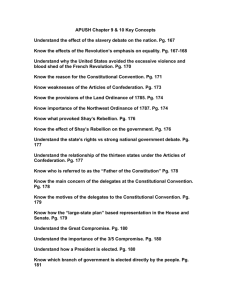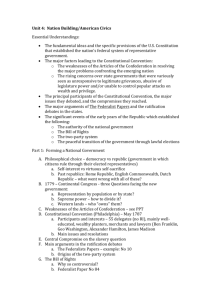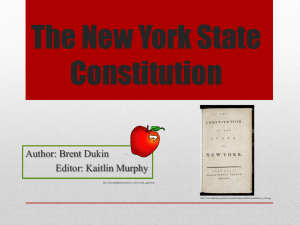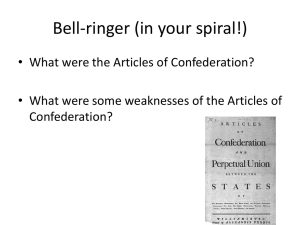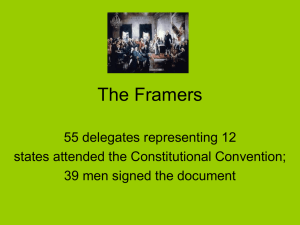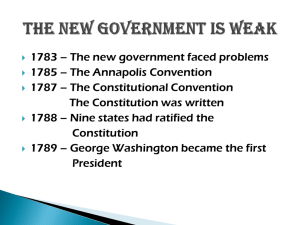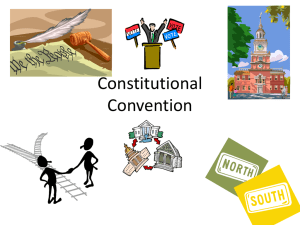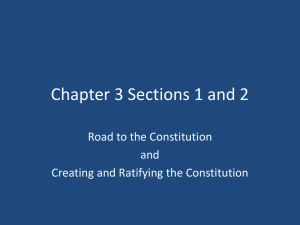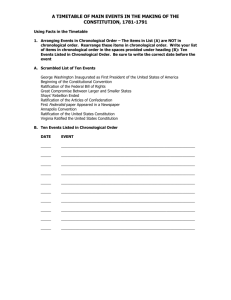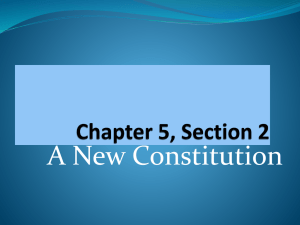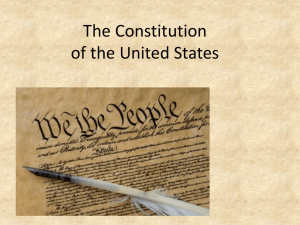AP US History - Ch. 8 The New Nation 1786-1800
advertisement
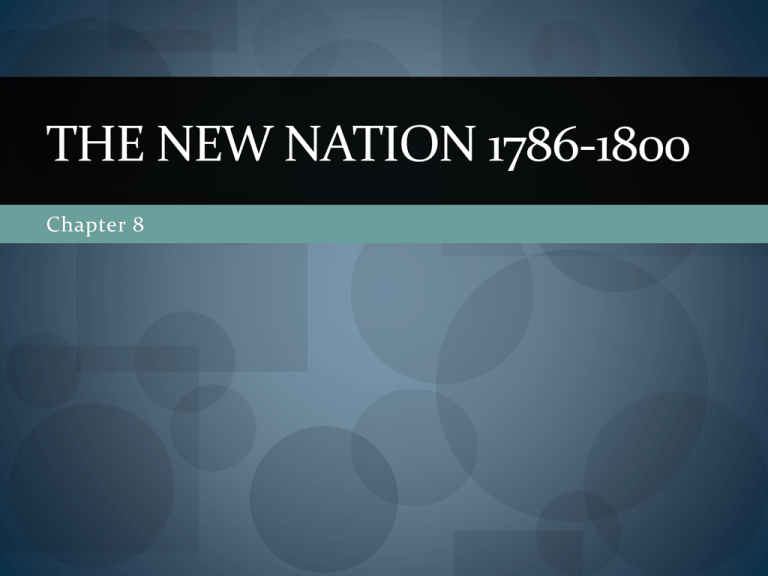
THE NEW NATION 1786-1800 Chapter 8 The New Nation: Key Topics The tensions & conflicts between local & national authorities in the decades after the Revolution. The struggle to draft the Constitution & to achieve its ratification. Establishment of the first national government under the Constitution. The beginning of American political parties. The first stirrings of an authentic American national culture. The New Nation Chapter Outline: The Crisis of the 1780s The New Constitution The First Administration Federalists and Jeffersonian Republicans “The Rising Glory of America” The Crisis of the 1780s Economic Crisis: Economic Crisis had its What factors origins in the Revolution: Shortage of goods due to British blockade, demand for supplies by armies, flood of paper currency caused inflation. contributed to the economic crisis of the 1780s? How did economic problems contribute to the creation of the national government? Shay’s Rebellion Massachusetts farmers, led by Daniel Shays, led a rebellion against the state’s high taxes. During the economic crisis, farmers were hurt the hardest. The rebellion turned into an uprising that the national government could NOT put down. Shay’s Rebellion Many saw the conflict as a class struggle: rich v. poor, debtor v. creditor. Finally, a state militia put down the uprising. Shay’s Rebellion Consequences: Showed the need for a strong central government. Supported the view of Nationalists, a group of colonial leaders like George Washington, who urged the Articles of Confederation were too weak because they gave too much power to the states and not enough power to the federal government. Their goal was to create a system of government with a strong central government. Annapolis Convention Annapolis, MD Convention Conference of 12 delegates (5 states) that issues a call for a convention to meet in Philadelphia to consider major changes to the government. The Constitutional Convention The Virginia Plan The Virginia Plan Presented by James Council of Revision- Madison. Scrapping the AOC Bicameral legislature; H of Reps based on population & Senate based on state legislatures consists of an appointed chief executive and national judiciary. Strong central gov’t Favored larger states The Constitutional Convention The New Jersey Plan- Favored the smaller states. Strong central gov’t Unicameral legislatureall states had equal representation Smaller states getting overpowered by the larger states. They were opposed and fought the Virginia Plan. The Constitutional Convention The Great Compromise- The plan proposed at the 1787 Constitutional Convention for creating a national bicameral legislature in which all states would be equally represented in the Senate and proportionally represented in the House. It provided for a strong national gov’t but still provided for an important role for the states. Expanded the powers of Congress Establishment of a strong single person executive Established the Supreme Court & national judiciary Constitutional Convention: 3/5’s Compromise There was also a debate between northerners & southerners over slaves and representation in Congress. Southerners wanted slaves counted for representation, but excluded in apportioning taxes. Constitutional Convention: 3/5s Compromise Issue of slavery persisted: Compromise stated that for every 5 slaves in the South, 3 would be counted as a person for representation. Also, the slave trade would end in 1808. Ratifying the Constitution Federalists Favored the ratification of the Constitution. May of the Federalists had been the Nationalists. Antifederalists Were opposed of the ratification of the Constitution. The issue…they wanted a bill of rights guaranteeing civil liberties. The Federalists Papers Written by James Madison, Alexander Hamilton and John Jay, the Federalists Papers were a series of essays published throughout the states. The original intent was to persuade New Yorkers to support ratification of the Constitution. Amendments: Additions/ Changes to the Constitution Ideas taken from state constitutions. First 8 amendments concerned with individual rights. Guarantees freedom of religion & expression as well as protection against arbitrary or wrongful legal proceedings. Powers not granted to the national government retained by the people or the states. THE FIRST ADMINISTRATION Section 2 Washington’s Presidency Congress passed two important pieces of legislation. 1. Judiciary Act of 1789 – It established the Supreme Court and the federal court system. 2. Judicial Review- A power that gives the federal courts the right to review and determine the constitutionality of acts passed by Congress and state legislatures. Washington’s Presidency- The Courts John Jay- the first Chief Justice of the Supreme Court. During the first decade, the Supreme Court heard very few cases. The ones they did hear, dealt with the power struggle between the states and federal gov’t. Chisholm v. Georgia- ( 1793) Washington’s Presidency- The Economy Virtually bankrupt after the Revolution, Congress passed the tariff of 1789, the first tariff of the U.S. It’s goal was to raise money and not protect American businesses from foreign competitors. Alexander Hamilton- Secretary of Treasury 1790 Report on the Public Credit Plan to reduce Revolutionary War debt a. Issue new interest bearing bonds b. Pay off foreign debt but not state debt c. Encourage foreign investment Charter a national bank a. The bank system would be run by the gov’t Government promotion of industry a. Report on Manufactures- provide funds for new industries and implement high tariffs. Washington’s PresidencySectional Differences State debts Placement of capital Foreign policy in Europe The French Revolution led to two camps regarding American foreign policy: 1. Hamilton and Nationalists believed
